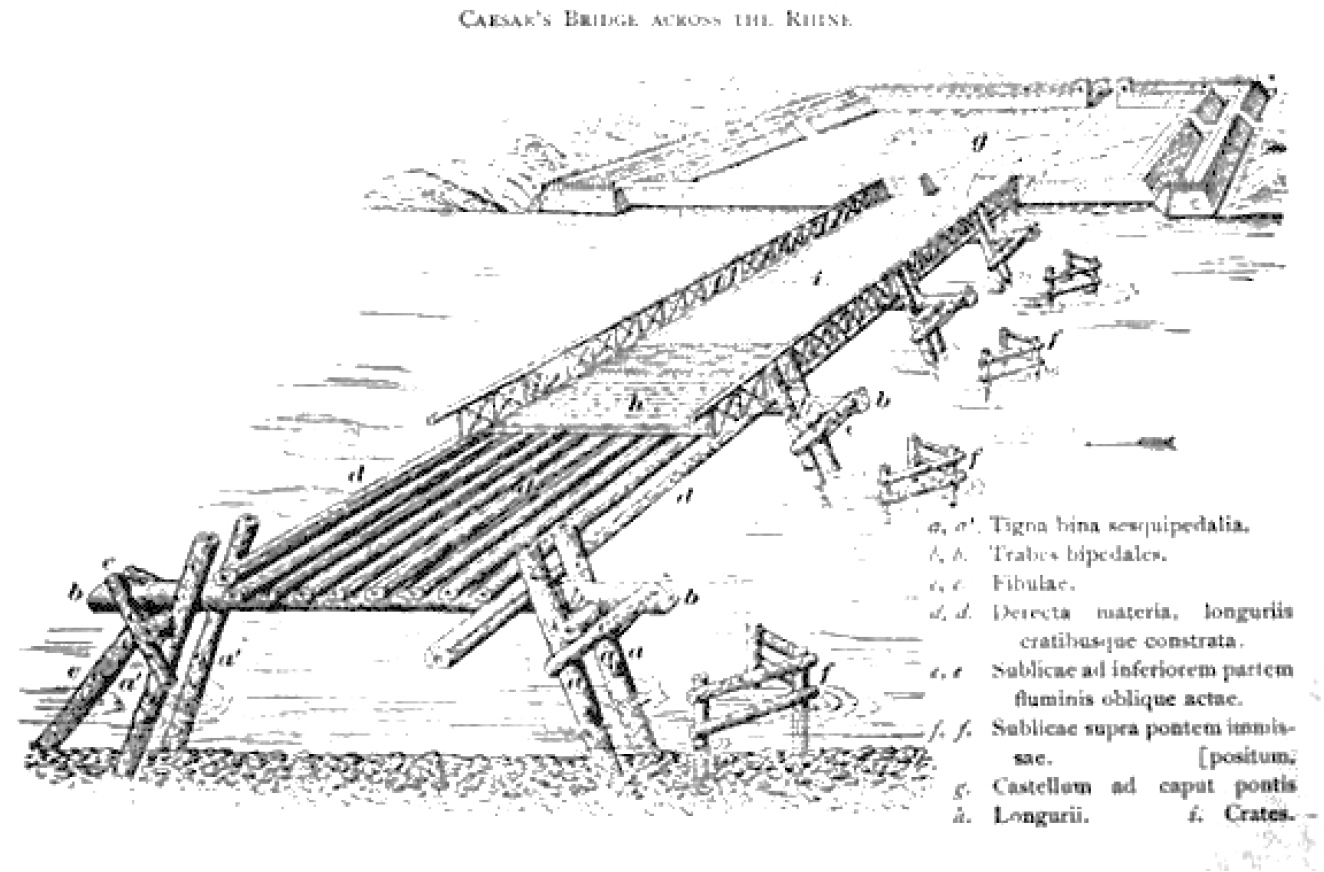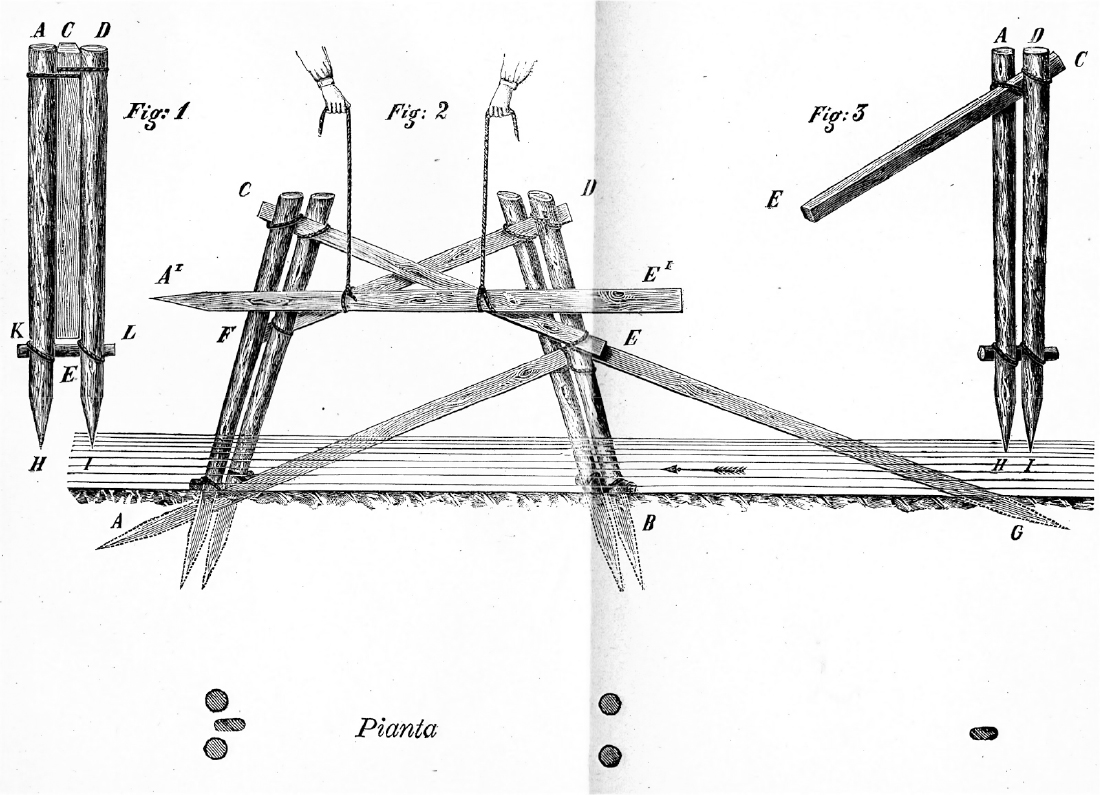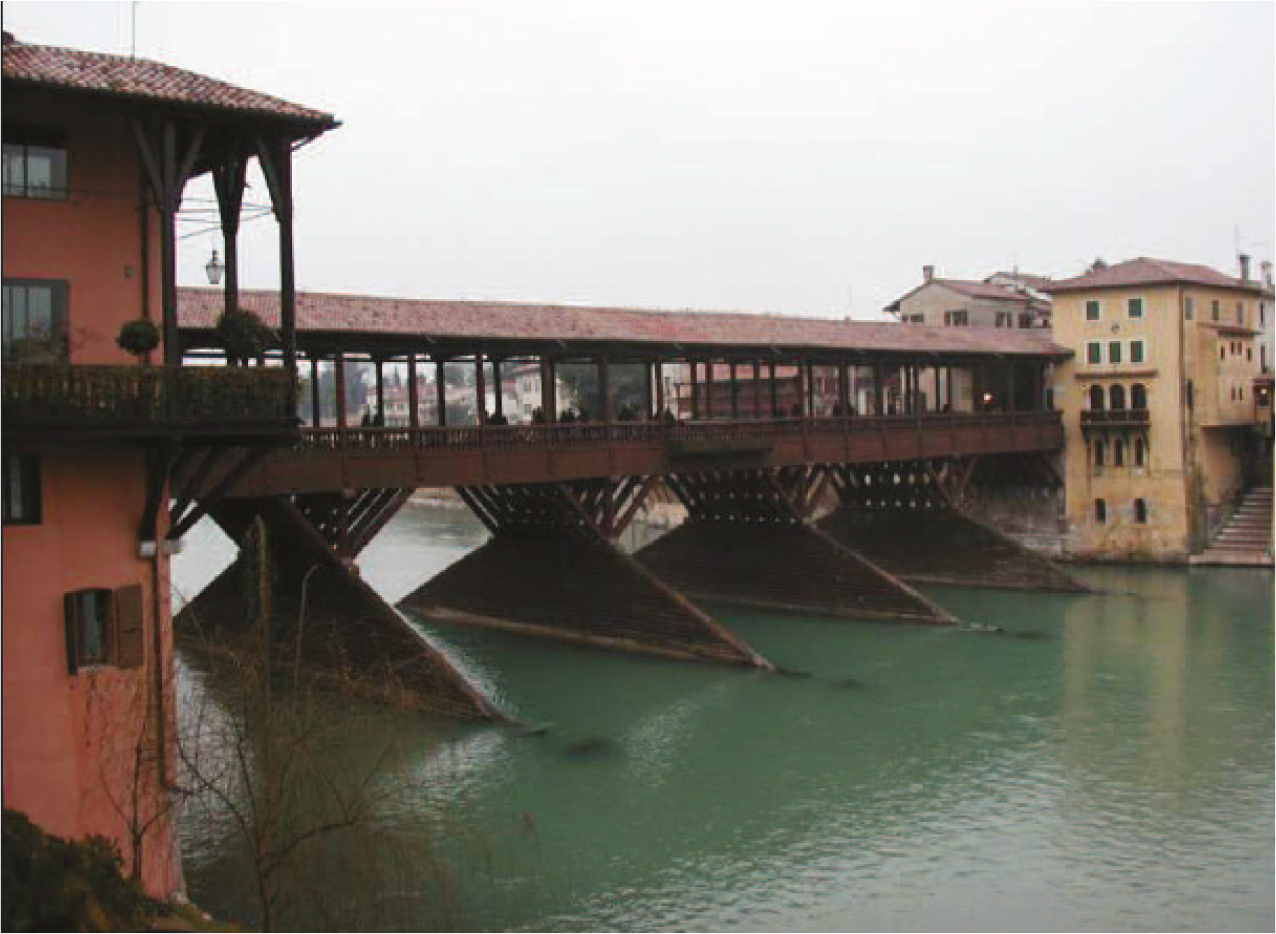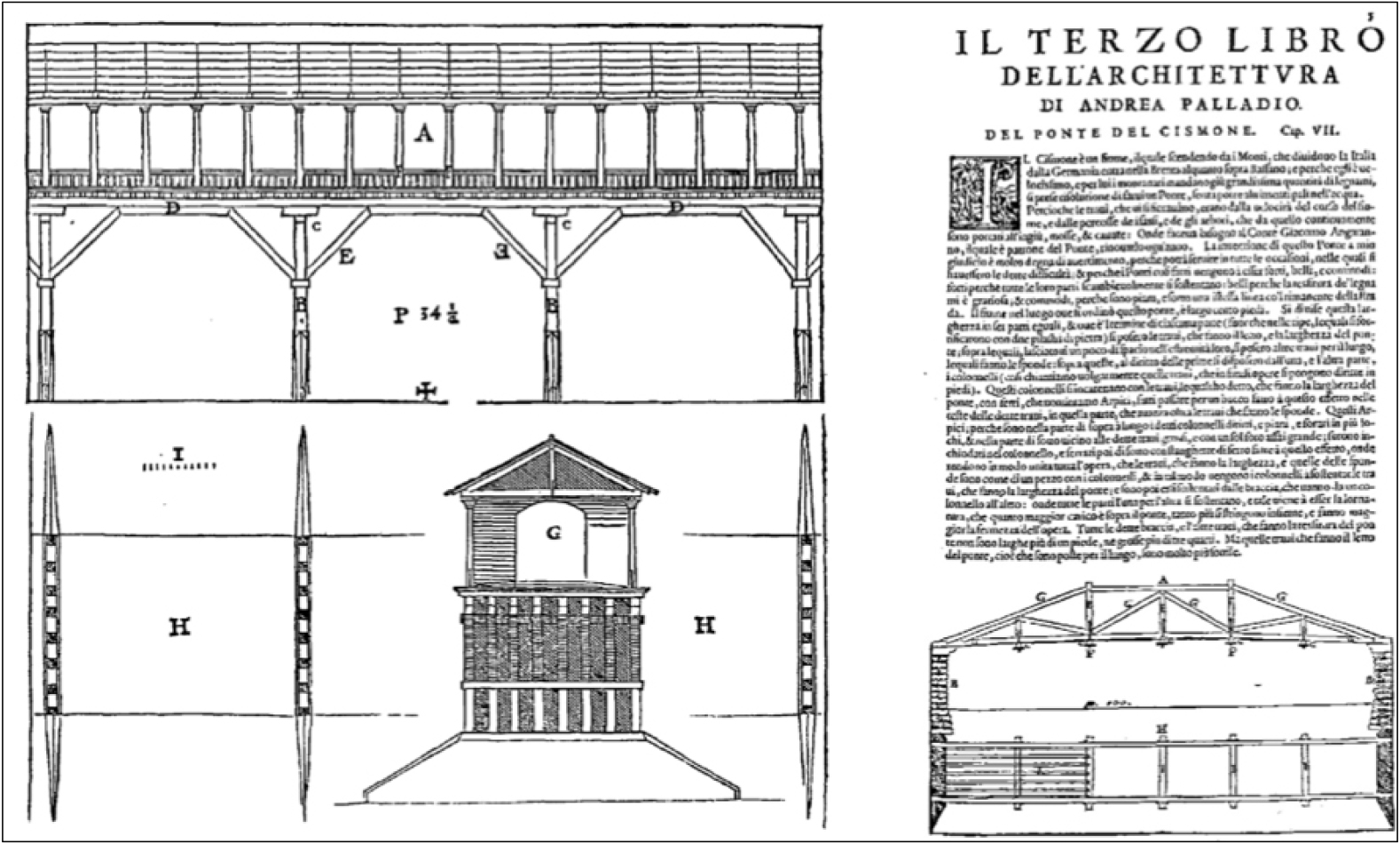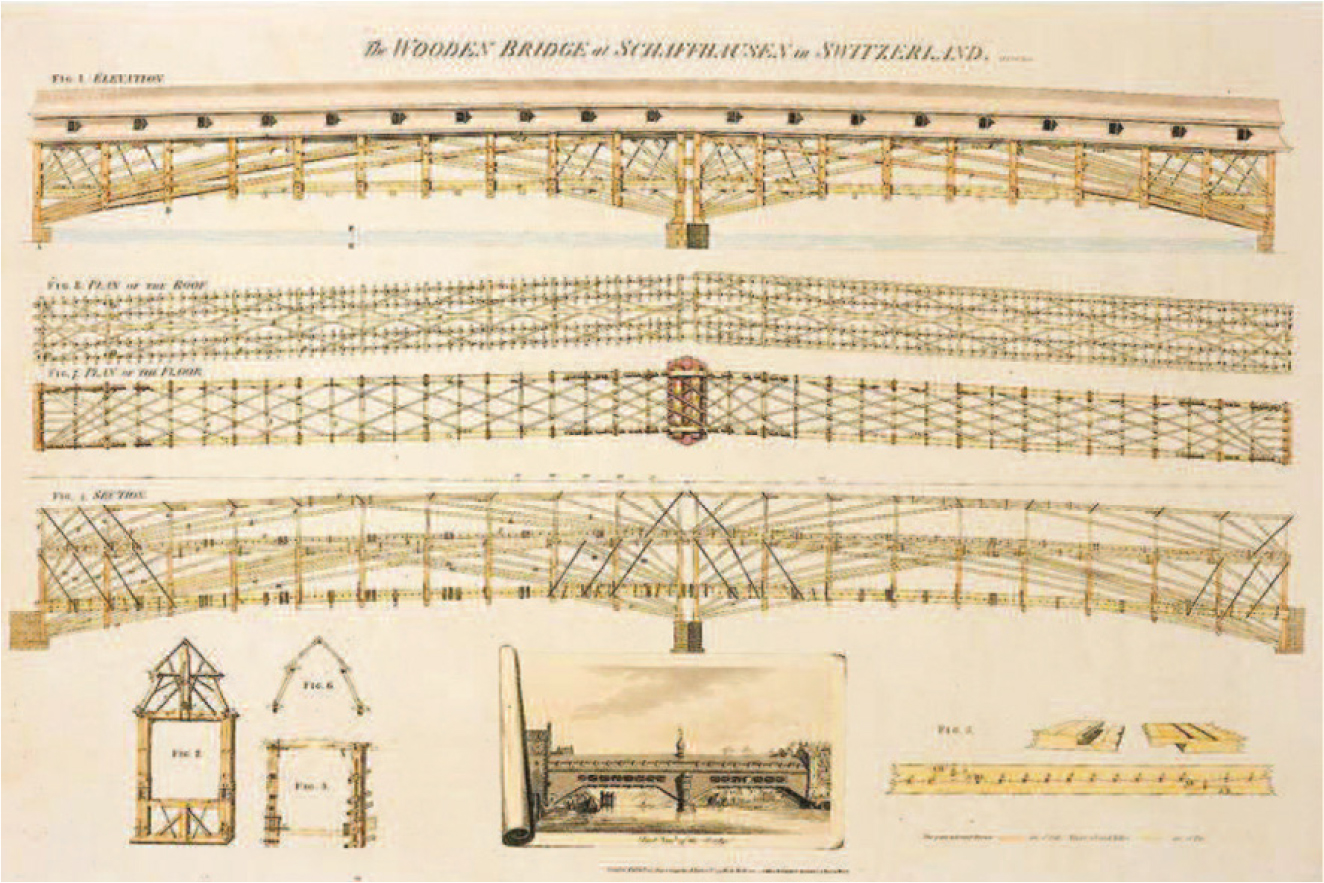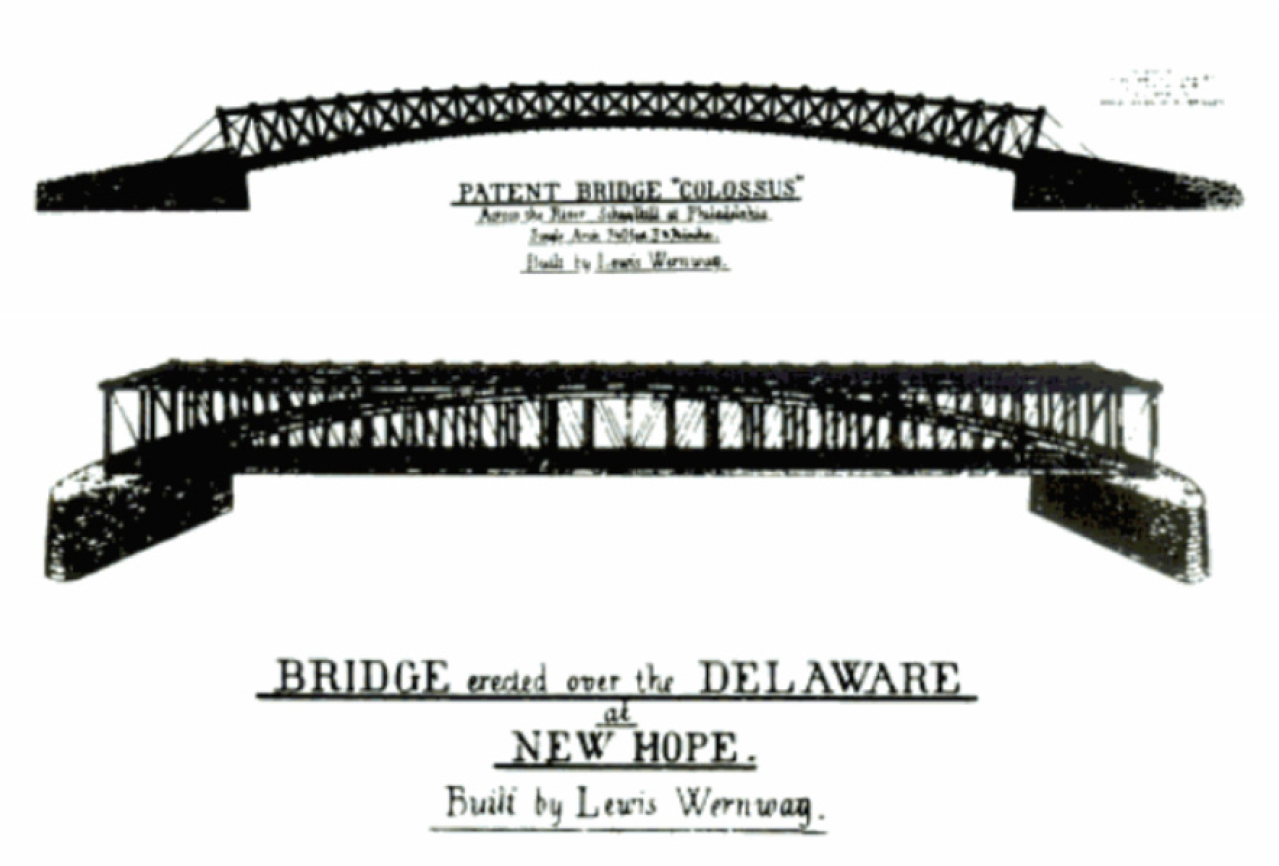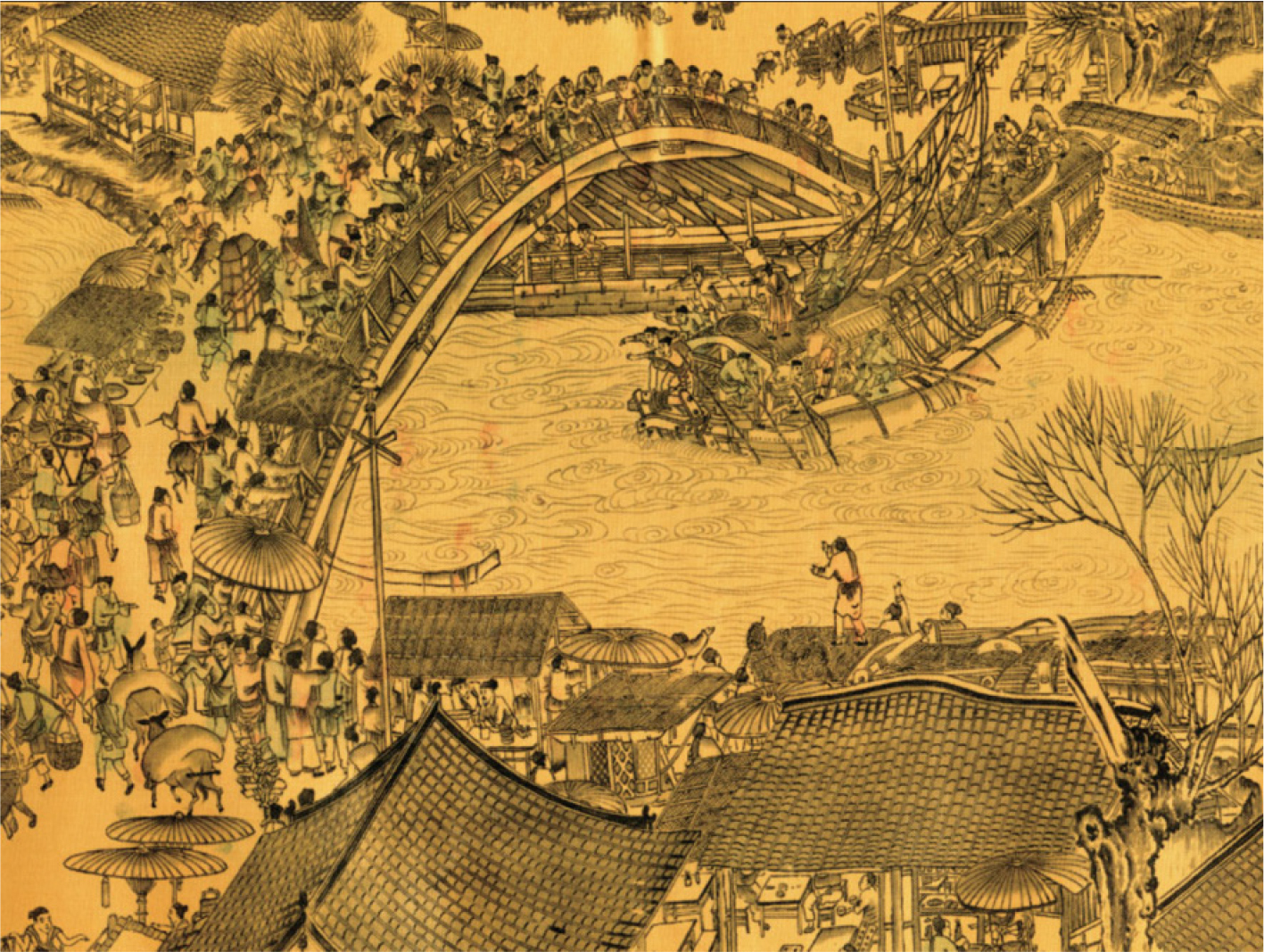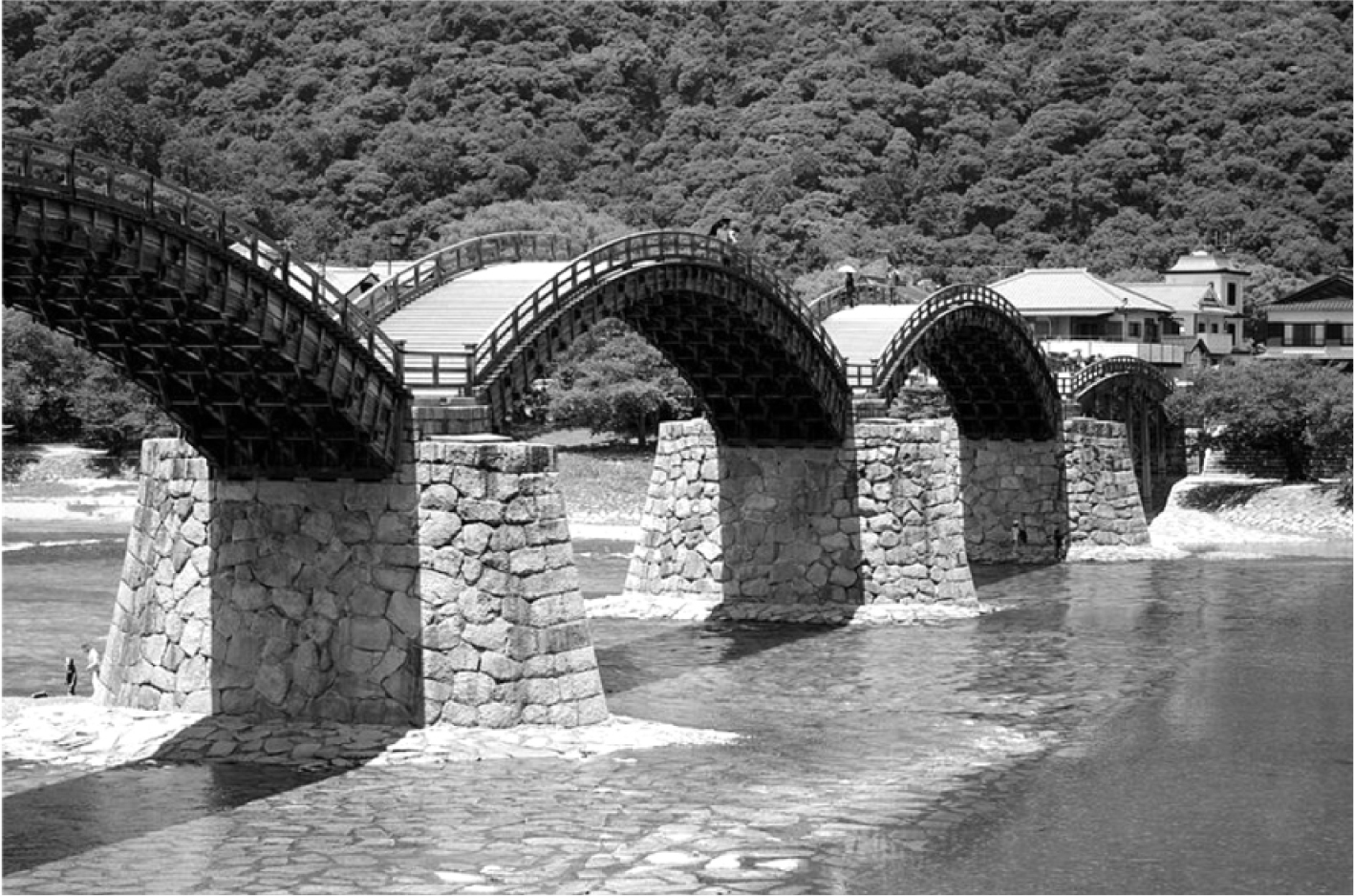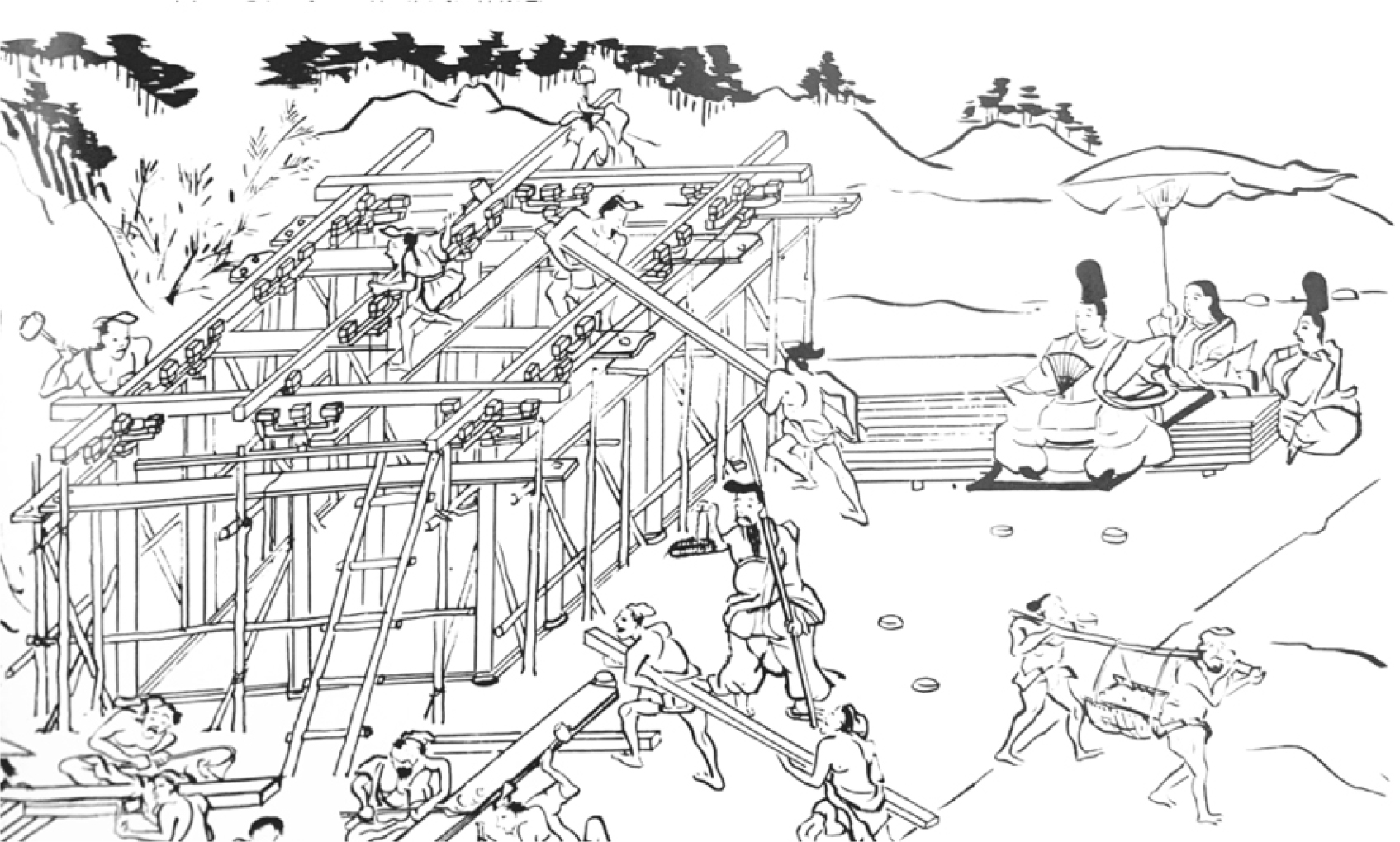Introduction
Selected historical examples
Guidelines to analysis, conservation, and maintenance. Towards a repertoire of wooden bridges worldwide
Criterion 1: Masterpiece of human genius
Criterion 2: Effect on construction developments
Criterion 3: Unique sample
Criterion 4: Proof of social, urban, and economic developments
Conclusions
Introduction
The construction of bridges has ancient origins. Since the Neolithic age the need to build a bridge has always had the same motivation: to overcome an obstacle offered by the particular configuration of the land or by a hydrographic reality, in order to facilitate both movements and contacts with neighbouring peoples as well as exchanges and trade.
The bridge, as architectural typology, has not had the same importance for all the ancient peoples. The Romans, great bridge builders, needed fast and safe connections to preserve and control their own Empire. From the 4th century until the 9th century A.D., however, interest in bridges declined considerably, since the political units were smaller and the costs for the construction and maintenance of such works were too high [1].
New discoveries, new technologies and the use of new materials revolutionized the construction methods; an innovative principle in the history of construction was undoubtedly the use of the arch, which made possible to create highly scenic and statically safe forms and structures. Subsequently, the introduction of materials such as iron and reinforced concrete opened new perspectives compared to those that could be achieved with wood and masonry [2].
However, wood has always been the potential material for the construction of bridges as it was available in abundance and highly renewable resource, although easily perishable. Over time, the wooden bridge took on increasingly complex and robust shapes in order to overcome larger spans, by surviving the spread of stone materials. The wood lent itself well to the construction of the trusses, thanks to its ability to withstand both tensile and compressive stress in the parallel direction to the fibres; its lightness made it particularly suitable for overcoming large spans. Among its negative characteristics, its vulnerability to humidity and fire, deformability and the difficulty in making joints, which are the real weak points of wooden structures, are the most dangerous.
Many ancient wooden bridges did not stand up to “stepmother” nature and destroyer man, so today there are few direct testimonies of them, but there are a lot of books and treatises rich in images, suggestions and highly specialized reliefs.
In 1716, Henri Gautier published the Traité des Ponts, the first treatise entirely devoted to the construction of bridges (timber structures, masonry, their foundations, piers, and centring, etc.), published when the empirical design of bridges gave way to the rationalism and scientific rigour. In France, during the second half of the 17th century, the Corps des Ingénieurs des Ponts et Chaussées, a group of architects and engineers, was reorganised by Colbert during the reign of Louis XIV. In 1747 the École des Ponts et Chaussées, the oldest academic institution in the world for training in road and bridge design, was founded. The first theoretical studies on the stability of arches, the transmission of forces and the most suitable form were conducted in this School by La Hire, Gautier, Bélidor, Coulomb and Méry [3].
A lot of research has focused on conservation techniques for wood as a building material, structural monitoring, and protection from potentially harmful agents [4, 5, 6, 7, 8, 9, 10]. Others are aimed at the history of construction and landscape, and the analysis of architectural typology [11, 12, 13].
This contribution, after an overview of the main historical testimonies of wooden bridges over the century, provides methodological and operational indications for studying and cataloging these artifacts, considering any architectural, urban and vulnerability aspects, to create a rich database and propose to activate a shared protection to national and international authorities.
The proposal should help both to support the analysis and enhancement of existing heritage and to promote awareness of the tangible and intangible values.
Deep knowledge of such these works - from architectural, structural, conservation, environmental point of view - allows to totally evaluate the state of the art of timber bridges and to have a shared document in each region of the world, permitting quick access to information for conservation, rehabilitation, and protection operations.
Selected historical examples
Timber bridges have always fascinated both non-experts and professionals. Their structural schemes are sometimes simple, sometimes more sophisticated as result of a complex combination of art, technique and craftsmanship. Symbolically they refer to wider meanings: they extend from one bank to the other, they cross the deep uncertainties of rivers, they connect people and places. The bridges demonstrate human intelligence and triumph over nature, challenging the limitations of gravity and bearing witness to the development of architectural technology over time [14].
In this paragraph some of the most illustrious historic examples all over the world are reported, obviously with the appropriate simplifications also in the light of the rich existing literature. However, it is necessary to underline the role that these artifacts have had throughout history, written not only by large monuments, buildings, and infrastructures, but also by small and magnificent examples of craftsmanship and construction skills, to be protected and transmitted to the future.
In the course of their history, these works have undergone an evolution for the development in the use of materials, structural behaviour, construction processes, increasingly improved technology, etc. The development of bridges is also due to the evolution of both transportation systems and characteristics of the road: the Romans travelled mainly on horseback, but also used two or four-wheeled carts; in the Middle Ages people travelled almost exclusively on horseback so that roads and bridges became narrower; from the 16th century bridges became wider for the passage of carriages; from the 19th century the passage of motor vehicles led to a further improvement in the characteristics of roads and bridges.
According to the material used, the history of bridges can be divided into two macro-periods: the period of stone and wood bridges (from the Romans to the end of the 18th century) and the period of iron and concrete bridges (from the 18th century to nowadays). The prehistoric villages mainly conceived and built suspension bridges using natural means (hemp, wood, textiles, etc.), made with the use of two parallel ropes to support a walkway, like today’s suspension bridges [15].
Timber bridges were generally built for pedestrians, animals, cyclists, or light vehicles. In general, it is possible to make the following classification: Timber beam bridges, Timber cantilever bridges, Timber suspension bridges, Timber arch bridges, Timber truss bridges, hybrid forms [11].
By designing territories and landscapes, wooden bridges helped to spread the development of construction over time, the power of technology, the effectiveness of science with all the suggestions of the progress.
The first Roman bridge, Sublicius Bridge (about 621 B.C.), was a pile-dwelling structure over the Tiber in Rome, which extended pedestrian access to the Aventine Hill. The first detailed description of a wooden bridge, a pile-dwelling structure over the Rhine built in 55 B.C. (Figures 1, 2), was written by Julius Caesar in his own De Bello Gallico[16, 17, 18, 19].
An incision on the Trajan’s Column reproduces the famous Bridge over the Danube (103-105 A.D.), built by Apollodorus near Kladora in Serbia at the time of Trajan’s expedition against the Dacians, consisting of 20 masonry pylons, on which 55 m long wooden arches rested. Trajan’s bridge is certainly the model for the first iron architectural work: the Ironbridge over the Severn in 1776.
These three famous wooden works (Sublicio Bridge linked to the heroism of Horace Coclid, the Bridge over the Rhine ordered by Julius Caesar and the Bridge over the Danube ordered by Trajan) are the demonstration of the very high Roman building cleverness and the potential of the material for the construction of safe infrastructures with a singular structural conception.
In the Renaissance, Leonardo Da Vinci designed wooden and masonry bridges, whose drawings clearly distinguish the tense elements, indicated as wires, and the compressed ones identified as rods [20]. Leonardo avoided the excessive fragmentation of the wooden elements which is the cause of undesirable deformations of the structural complex with excessive wear of the joints, as experienced later by Gustav Adolf Breymann (1807-1859) in his General Treatise on Construction of 1849.
The best existing model survives today on the Brenta River in Bassano a Grappa (Figure 3), near Venice in Italy, designed by Andrea Palladio in 1561, destroyed in 1945 and rebuilt identical to the original in 1948. The bridge over the Cismone in Trentino, by Palladio, arched with a span of 36 m in the 16th century, no longer exists [21].
These famous bridges show the innovation of the construction process in 16th century. In recent years, the Professor Jacques Heymann verified positively, with the calculation, the dimensions of the members of the ancient structure [22].
The numerous floods of the Cismone river led to the destruction and subsequent reconstruction of the bridge several times, until it was destroyed and never rebuilt (Figure 4). The Bassano Bridge has a more traditional configuration, with multiple knotted frames stiffened on the two facades surmounted by trusses arranged in the opposite direction to support the roof.
It was during the 16th and 17th centuries that engineers began to apply to non-military works the technical and project management skills that military engineers had developed over the previous three centuries [23]. These were mainly hydraulic engineering works such as soil drainage, flood prevention, canal construction and river bridge construction, many of them made of wood (Figure 5).
The best achievements, true masterpieces in the field of wooden bridges, took place in Switzerland in the 18th century. The most famous were two brothers, Johannes and Ulrich Grubenmann, who built bridges in Schaffhausen, Reichenau and Wettingen, combining diagonal struts and trusses to make spans considerably longer than the other bridges of the time. The Schaffhausen Bridge (1757) on the Rhine in northern Switzerland had two spans of 52 and 59 metres respectively (Figures 6, 7), burned in 1799 during the Napoleonic Wars. Rumlangbrücke (1766), with a span of 27 metres, is one of the few surviving Grubenmann bridges.
The use of wood for the construction of bridges in America in the 19th and 20th centuries was very widespread, fascinating the European engineers experienced in such works. Particularly noteworthy is Louis Wernwag’s Colossus built in 1812 (Figures 8, 9), the 104-metre arched truss over the Schuylkill River in Philadelphia, the longest span bridge in the world at that time. Examples that still survive today include the Cornish-Windsor Bridge (1866) over the Connecticut River (Figure 8) and the Bridgeport Bridge (1862), with a span of 63 m. According to the National Society for the Preservation of Covered Bridges Inc., about 800 covered wooden bridges survive in the United States, more than in any other country, becoming a true icon of the American landscape [24].
The practice of building wooden infrastructure also has very ancient roots in Asia, especially in China and Japan, where the origin of many forms of bridges is attested. Marco Polo told about 12,000 bridges built in wood, stone and iron near the ancient city of Kin-sai; the first bridge, the Panhogiao or Panho Bridge, was built during the Han dynasty in 206 BC.
After the decline of the Roman Empire, the construction of public works in Europe came to a standstill, while in the East it continued with considerable success. In fact, in East, wooden bridges have developed independently of Western culture. Here bridge builders experimented with shapes and materials, by perfecting their techniques, often preferring the use of wood as the main building material in Eastern countries (Figure 10). Many examples, in the countryside and parks, represent works of exceptional uniqueness, which have helped to create the myth of picturesque oriental landscapes, made of nature, architecture and engineering combined in an impressive functional harmony [25].
In China, there are numerous covered wooden bridges crossing local rivers and streams, characterized by extraordinary beauty, charm and technology. In the Taishun area there are at least 32 bridges from the Ming and Qing eras, 6 of which are made of very precious wood, which still serve the local inhabitants in their travels. In fact, the inhabitants take care in the conservation of the artefacts, with cyclical maintenance operations and tourist and cultural enhancement.
Many of them are recognized as Chinese Cultural Heritage and, since 2009, due to their construction technique, the Taishun bridges are recognized as UNESCO intangible cultural heritage. During the years, some old bridges were destroyed to build roads in the 1950s or destroyed by calamitous events over the years.
Cantilever bridges have been built in Japan since the 13th century, and there are still many testimonies in different parts of Asia: The Sharw-Hasi Bridge on the Katsura River has a span of 30 meters (Figure 10), the Wandipore Bridge in Buthan between India and Tibet with a span of 34 meters existed until the beginning of the 19th century.
In Japan, the Kintai-kyo at Iwakuni in 1674 (Figure 11), with its five interwoven wooden arches, carved and connected by dovetail unions, is one of the most famous and imaginative bridges. Built in 1674, the Kintai-Kjo footbridge over the Nishiki River is a classic bridge with five 35-metre span arches, where the extrados of the arch acts as the carriageway. The structure has been reconstructed several times - according to the oriental modus operandi to easy remakes the architecture -preserving the sophisticated Japanese craft tradition (Figure 12).
Guidelines to analysis, conservation, and maintenance. Towards a repertoire of wooden bridges worldwide
The selection of timber bridges worldwide over the centuries - only some of them reported in the previous paragraph - shows the great variety and heterogeneity of these works, characterized by regionalist peculiarities, craftsmanship, technical knowledge, mimesis with the surrounding nature and functionality. These values, which would make such artifacts as World Heritage Sites (WHS), must become guiding principles in the conservation, maintenance, and rehabilitation programs.
Not all wooden bridges are universally recognized as WHS, however special protection must be given to them to prevent the loss of secular material and intangible values. The World Heritage Convention (1972) states that to be declared a World Heritage Site a monument or site must have exceptional universal value, in terms of art, architecture, engineering, technology, transport, communication, industry, history, culture or nature. Therefore, sites and monuments must meet one or more of the criteria of authenticity and exceptionality developed by UNESCO and ICOMOS over the years.
A special global effort is needed by many different actors (architects, engineers, historians, politicians, populations, etc.) to identify these wooden structures, collect any useful information (architecture, structure, functionality, environment, etc.) and encourage protection and conservation programs, verifying whether, in accordance with specific selection criteria, they could be candidates to be officially recognized as a World Heritage Site [26].
Criterion 1: Masterpiece of human genius
The wooden bridges have been designed and built by engineers, technicians, and architects often by great fame for the times they lived, and their construction has involved entire populations, eager to provide their territory with the most advanced infrastructure and come out of isolation. Therefore, they should be considered not only celebratory of their own style and technique but also of the skills of those who conceived and built them.
Criterion 2: Effect on construction developments
These works have had a great influence on developments in engineering and architectural theory, technology, construction, transport, and communication systems. The development of technology, in fact, has a fundamental role in the process of recognition of these works as Cultural Heritage in terms of connections, forms, construction methods used, experimental construction techniques, advanced systems of hydraulic and geotechnical engineering, etc.
Criterion 3: Unique sample
Many bridges reach levels of exceptionality for their ingenious construction or their ability to survive over time, beyond the abuses of nature and man. Therefore, some of the aspects that help to designate such works as WHS are both originality and authenticity, typicality, and exceptionality as well as historical-material integrity.
Criterion 4: Proof of social, urban, and economic developments
Historic wooden bridges have been an opportunity for social development for many territories and populations, as well as representing an opportunity to “draw” the face of villages and towns over time, providing them with innovative and iconic infrastructures of the landscape in which they fit.
Critical issues that need to be addressed in the development of conservation or restoration plans for historical wooden bridges include historical analysis, owner needs, understanding of the original and current structural operation, restoration or reinforcement of the horizontal system and truss system when present, protection from moisture and running water and, finally, economic considerations.
The restoration of any historical work requires a deep appreciation of the intuition of the original designers and builders, of the avant-garde technologies of the various eras, the way they are perceived by the community and the economic and social implications. The wooden bridges all over the world, firstly created to meet mere connection needs, become unique and exceptional examples of wooden architectural production over the centuries.
Many of them have been lost due to obsolescence, structural inadequacy, poor maintenance, natural events or deliberate vandalism. Preserving the few that still remain means preserving these engineering and architectural paradigms and addressing the various critical issues involved through a broad and multidisciplinary conservation and rehabilitation project.
Conservation and restoration programs must always be sensitive to the implicit vocations of the building, to the new needs and to the mitigation of the structural deficiencies. Often, in the restoration of a wooden bridge, the use of exact replicated components of the original construction elements can be a correct way, but it is rarely easy to achieve for each constituent. Usually, it is necessary to reach a compromise to balance both the need to preserve the historical example and provide a safe bridge for community use. Choosing the most appropriate treatment for a structure requires a careful decision making on its historical significance and the importance in the socio-cultural development of a country, as well as its physical condition, current use, and current regulatory requirements (Figure 13).
The following guidelines for the conservation of these artefacts are drawn up starting from the ICOMOS Document “Principles for The Preservation of Historic Timber Structures” (1999) whose primary aim is to maintain the historical authenticity and integrity of the wooden cultural heritage. In general, any proposed intervention should follow traditional means; be reversible, if technically possible; be not prejudice or impede future preservation work whenever this may become necessary.
These methodological and operational guidelines encourage the conservation of the greatest amount of historical material, together with the ancient form of the structure, its characteristics, and original technological details. At the same time, the addresses for rehabilitation recognize the need to modify the structure to satisfy contemporary uses, when strictly necessary, while maintaining its authentic character.
1. Knowing the historical, functional, and technological evolution
This preliminary phase makes possible to examine the artifacts’ history, to understand the original and evolutionary processes, as well as the functional vocations (pedestrian bridges, waterway crossings, caravans, etc.). The historical-documental research makes possible to reconstruct authentic forms and styles, to know the technological details, stories of use, reuse, reconstruction and restoration. In this phase it is possible to verify the authenticity of the artefact and to carry out the “test of the 4 WHS criteria”.
2. Understanding the original structural behaviour
The rehabilitation project always involves fixing, rebuilding or replacing deteriorated, faulty or missing components. From the historical preservation point of view, it is preferable to replace or repair the original components to exactly replicate them. From an engineering point of view, it is necessary to know the original structural operation and the static reasons why the problem has occurred or may occur.
3. Understanding the current structural behaviour
This phase involves in-depth inspection and structural evaluation. In particular, the structural analysis must consider local or secondary stresses at the connections, which are often the main cause of failure of the bridge and some of its components. The most modern monitoring and structural analysis systems can be used, considering the historical construction method, material characteristics, safety conditions, potential vulnerability to deterioration and costs.
4. Understanding degradation factors and damage mechanisms
Wooden structure must be protected from its enemies, including moisture, fungi, insects, fire, abrasion, and excessive stress [27]. Many of the problems and difficulties are associated with dimensional alterations caused by changes in its moisture content, by causing cracks, deformation or crushing. In addition, all historical wooden objects are at risk of attack by insects and fungi, even if some species of wood are partially or totally resistant to such organisms.
Knowing the degradation factors and damage mechanisms makes possible to quickly implement the most careful and scrupulous remediation practices, valuated case by case [28].
5. Understanding the best repair and conservation work
According to the best method of restoration and rehabilitation, it is possible to talk about reinforcements of the floor, pillars, connections and covering system. Often total replacement is not feasible, sometimes it is acceptable to strengthen the member by joining another one, preferring the overlapping of wooden elements, connected by small stainless-steel elements, which do not cause further damage to the structure.
It should be noted that while historical wooden bridges have typically been built using wood species indigenous to the places where they were located, replacement elements of the same species may not be easily available today.
At the same time, contemporary materials and techniques should be chosen and used with the highest caution, and only in cases where the durability and structural behaviour of the materials and construction techniques have been satisfactorily proven over a long period of time. Utilities, such as heating, and fire detection and prevention systems, should be installed [29].
6. Planning appropriate management, protection, and safeguarding measures
Timber bridges worthy of WHS status should have mandatory legal protection and management tools to ensure their preservation. The existence of safeguard legislation at national, provincial, or municipal level is essential and must be clearly stated in any restoration, recovery, and conservation project. Citizens and local communities also strive to explore ways to ensure the historical-material integrity of such works so that they can continue to play a critical role in current urban systems and preserve part of the cultural heritage for the benefit of future generations.
7. Final form for Timber Bridges Database
At the end of the process of restoration and rehabilitation of the work, the person in charge is responsible for filling in the final form useful to enrich the international database of wooden bridges recognizable as WHS. In this form the general data of the work, the state of art and the project status as well as the accomplishment of the four criteria, will be reported (Figure 14).
This form should flow into an electronic database that can be consulted by professionals, administrations, protection entities and by all those who care about the knowledge and the safety of these works.
Conclusions
The subject of bridge design and construction is one of the most interesting in the history of construction in the spheres of architecture and engineering, social, civilisation and technology.
According to the evolution of the wooden bridges, particular importance has taken the domination of nature, the possibility of controlling the territory, the opportunity for commercial and cultural exchanges between populations otherwise divided, the overcoming of technical difficulties related to the design and execution as well as the instability of construction sites. Over the centuries, progress in mathematics and calculation, knowledge of curves, and new structural concepts have led to a new art of bridge building, which is increasingly performing.
These works have played an important role in the history of human settlements, firstly to cross rivers, straits and valleys, then they became a noble craft of builders. For Andrea Palladio “bridges should adapt to the spirit of the community by displaying merchandise, firmness and delight”.
In order to preserve the legacy of wooden bridges, it is necessary to follow cautious and prudent approaches and actions, capable of interpreting the structural behaviour, knowing the causes of deterioration and defining the possibilities of resolution. These procedures make possible to orient any choice on the priorities and quality of each intervention, in order to guarantee the transmission of tangible and intangible values to the future. The collection of information (geometry, design, craftsmanship of the joints, etc.) is an important step for the diffusion of the traditional knowledge of these constructions which, if culturally and legally recognized as World Heritage Sites, would be better protected and safeguarded.
The methodological and procedural approach of investigation and planning of operations, conceived within the guarantee of recognition as WHS, allows to start good practices for the identification, recovery and restoration of wooden structures, so that these architectural types, besides being legacy of the past, are also a promise for the future.
The regeneration of values linked to the cultural and material significance of historic wooden structures through protection and conservation programs is an essential requirement of a forward-looking sustainable development policy, at local, national, regional, and international level.



